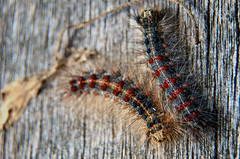Non-Native Invasive Insects / Animals
In Harpers Ferry National Historical Park (NHP), native insects play a vital role in natural communities, but non-native invasive insects threaten to overwhelm some natural communities.
Why are non-native insects any more disruptive than native ones? Ecobit: The Making of a Pest Not all of the insect pests listed below have reached Harpers Ferry NHP, but all are on course to do so. Pests marked "potential" are threats to the park, but have not yet been confirmed there.
Explore this page:
Non-Native Insect Pests
Gypsy Moth
 Colorful gypsy moth caterpillars (Lymantria dispar) are destructive to oaks and many other species.
Colorful gypsy moth caterpillars (Lymantria dispar) are destructive to oaks and many other species.
Photographer: Flickr user Dennis WilkinsonThe gypsy moth (Lymantria dispar), native to Europe and Asia, became established in America in the late 1800s and reached the mid-Atlantic region by the late 1900s.
Emerald Ash Borer
 An adult emerald ash borer (Agrilus planipennis).
An adult emerald ash borer (Agrilus planipennis).
Photographer: U.S. Department of Agriculture.The emerald ash borer (Agrilus planipennis), originally from Asia, is attacking ash trees in Harpers Ferry, and has the potential to wipe out most of them.
Hemlock Woolly Adelgid
The hemlock woolly adelgid (Adelges tsugae), native to Asia, has killed most of the mature eastern hemlock trees at Harpers Ferry NHP.
Ecobit: Hemlock Woolly Adelgid
In the shady, north-facing coves where eastern hemlock trees previously flourished in the canopy, the natural community is in flux.
Asian Long-Horned Beetle (potential)
 Asian long-horned beetle (Anoplophora glabripennis).
Asian long-horned beetle (Anoplophora glabripennis).
Photographer: Gillian Allard, FAO of United Nations. Bugwood.org.The Asian long-horned beetle (Anoplophora glabripennis) can kill mature trees of many species.
Ecobit: Asian Long-Horned Beetle
As of 2017, this beetle had not yet appeared in Harpers Ferry NHP. Host trees include maple, box-elder, elm, birch, sycamores, and willows.
Viburnum Leaf Beetle (potential)
 A viburnum leaf beetle larva (Pyrrhalta viburni) on a skeletonized Viburnum leaf.
A viburnum leaf beetle larva (Pyrrhalta viburni) on a skeletonized Viburnum leaf.
Photographer: Flickr user dogtooth77A Eurasian beetle called the viburnum leaf beetle (Pyrrhalta viburni) attacks viburnum plants and can kill them with repeated infestations.
Sirex Woodwasp (potential)
 Sirex woodwasp (Sirex noctilio).
Sirex woodwasp (Sirex noctilio).
Photographer: MichaellbbeckerThe sirex woodwasp (Sirex noctilio) can weaken and even kill pine trees.
Beech Bark Disease
Beech bark disease can kill large American beech trees after a non-native beech scale beetle (Cryptococcus fagisuga) has created tiny holes in the bark, allowing spores of a non-native fungus to enter. It is the fungus that kills the trees. See Plant Diseases of Harpers Ferry NHP for more.
You Can Make a Difference!
It is much easier to control invasive insect incursions that are identified and addressed early. The National Park Service keeps a vigilant watch for these pests and asks you to do the same. When you’re visiting Harpers Ferry NHP, you can help keep natural communities healthy by being observant and sharing what you see with park staff. Ecobit: An Extra Set of Eyes


